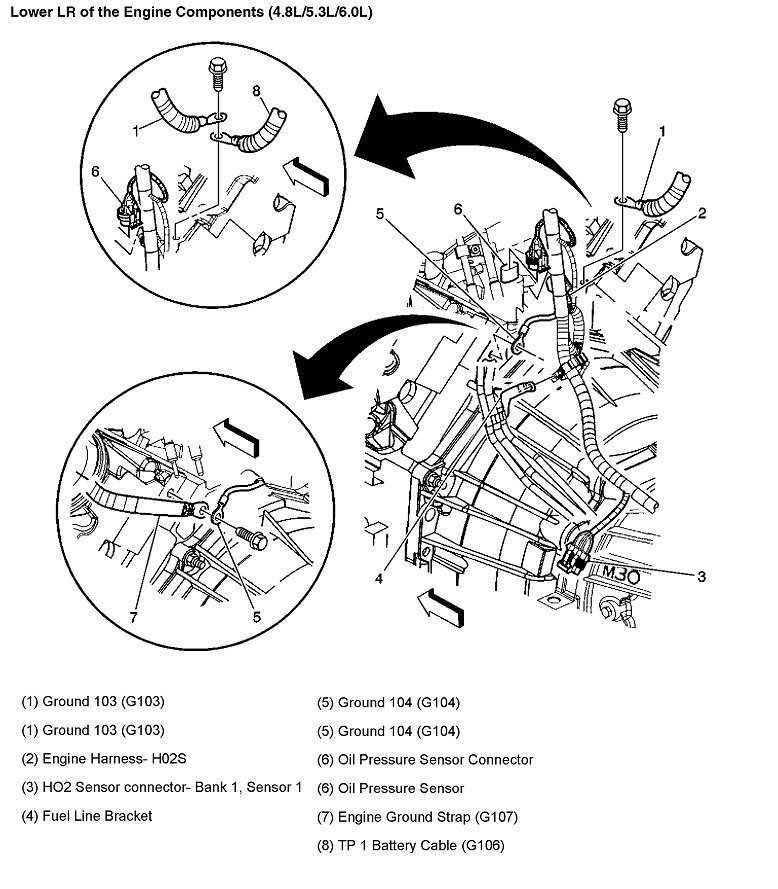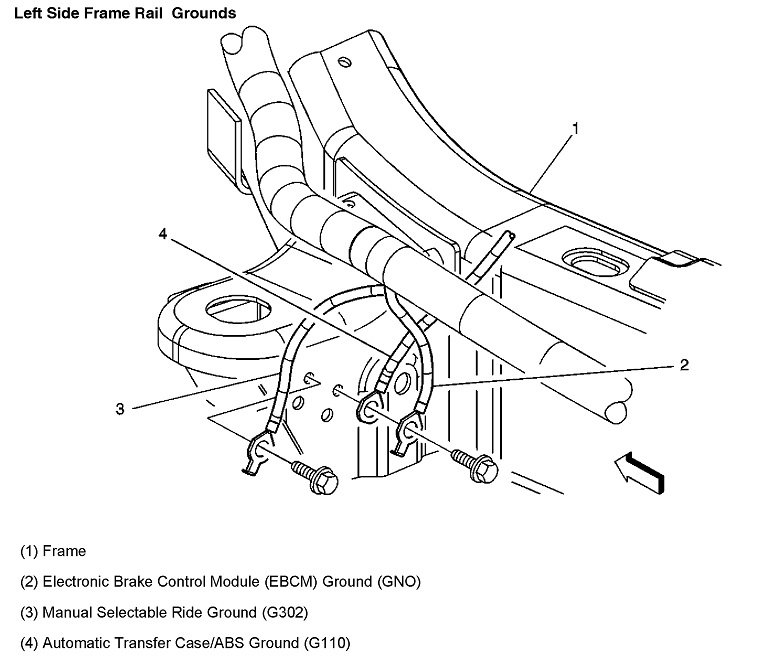This isn't as important as you might think. Everything on the engine is grounded to the battery's negative post through the fat battery cable that's bolted to the engine block. Everything on the body is grounded to the battery through the second, smaller negative wire coming off the cable. That's all you need for everything electrical to work. The engine and transmission are mounted on rubber mounts that insulate them from the frame and body. That's why the two different ground wires are needed. The ground wire for the engine also has to be large enough to handle the 300 or more starting amps to get the starter motor going, then it drops to around 200 amps or less, which is still a lot. The lights and many computers use much less current, so that second negative wire can be smaller.
Most of the time the body is mounted on rubber mounts too that isolate vibration, but that also isolates it electrically. If anything electrical was grounded to the frame, that also needs a return path to the battery. Rather than run a third wire back to the negative post, there will just be ground straps bolted between the frame and body. In addition, even if the frame is not used to ground items, the magnetic fields set up around wires when current is flowing though them can set up stray voltages that "induce" voltages magnetically into wires in harnesses or into nearby sensors and computers. Most commonly we used to hear that as excessive noise on AM radio. In a worst case example, static electricity would build up in some early '60s models, leading to arcing, pitting, and rapid failure of front wheel bearings. Adding ground straps in specific places shorted out, or grounded that static build-up.
The ground straps you're looking at serve a similar function. No electrical device or circuit on your truck requires those straps to operate, however, we don't always know the reason the engineers found that made them necessary. Radio noise is the most known problem. Normal arcing from the brushes in the wiper motor can cause radio noise, and anything that can cause radio noise can also interfere with computer sensor signals. When current flows through a wire, that sets up an electromagnetic field around that wire. (Remember picking up paper clips with a small battery, wire, and nail)? Anytime you place a wire in a magnetic field, that induces a voltage in that wire. We have to add one more ingredient, (movement), to have that induced voltage cause current to flow. That's why we have to spin generators with a belt and pulley. The "movement" in my wire example is the changing magnetic field that results from the changing current through the first wire. That changing current can be the result of arcing brushes in a motor, circuits being switched on and off, and even digital signals between computer modules.
The point of all this is we need to ground, or short out, any voltage spikes, static build-up, and any stray electromagnetically-induced current that could interfere with computers, the radio, and even the electronic instrument clusters. Under-hood lights generally have their own feed and ground wires, but even if the truck doesn't have one of these lights, it's common to find a ground wire between the firewall and hood. Same types of ground straps can be found between the inner fenders and frame rail. Removing those straps won't cause any circuit to stop working, but the engineers found a need for them.
Along these lines, it's also important to route your new harness in the same place as your old one. Mispositioning one harness on a Ford truck can allow a spark plug wire to induce a voltage spike into the right front anti-lock brake sensor wire and make it look like the right front wheel is still rotating when the truck is standing still. The fix was to put the sensor wires back where they were supposed to be. All vehicles today use at least three pairs of data buss wires where all the computers talk back and forth to each other. Those digital signals are very weak and easily affected by stray magnetic interference. To prevent that, data buss wire pairs are always twisted around each other so any interference affects both wires equally and the difference is cancelled out. Interference can still be a factor if the harness those wires are in are placed too close to other harnesses or other sources of magnetism.
One of the worst offenders of voltage spikes is GM's generator that was redesigned for the '87 model year. The battery is the key component in damping and absorbing those spikes, but as they age and the lead flakes off the plates, they lose their ability to do that. Those spikes can destroy the generator's built-in diodes and voltage regulator, and they cause spikes in current flow through the output wire running back to the battery. Any wire that lies adjacent to that output wire will have similar voltage spikes induced into it. If one of those is the signal wire from an engine sensor, it can cause all kinds of elusive running problems that defy logic. The way we identify those is to unplug the generator. If the running problem clears up, it's due to a combination of generator design, aged battery, possible failure of one of the six internal diodes, and in rare cases wire harnesses improperly routed.
I know that's a long story to explain why they have all those ground straps. You only need two ground wires to run the truck. One large one that bolts to the engine, and one smaller one that bolts to the body. The rest are to address interference problems. Many are redundant so if one corrodes off, you still have another one or two. When you have two on the back of the engine, it can also be because they don't want those stray currents to have to flow through the engine from one side where that interference is generated, to the other side where it gets shorted out. Passing through the engine might cause that current to pass next to some wires, and still induce stray voltages. They want interfering voltages to be grounded out right at the source.
Rather than needing a trip to your chiropractor, to do the repair properly, I would still use that ground strap that's giving you trouble, but consider moving it to where it's easier to work with. If it bolts to the firewall, keep it on the firewall but use a nearby bolt that's easier to get to. Same on the engine end of the strap. One of the things GM is famous for is efficiency and speed on the assembly line with little regard to the people who have to work on it later. That ground strap was real easy to attach to the firewall before the engine was installed.
These drawings show some of the grounds, but they don't show the straps separately. They have them on the fuel filler tube and tank too.
Images (Click to make bigger)
SPONSORED LINKS
Thursday, March 17th, 2022 AT 1:04 PM





